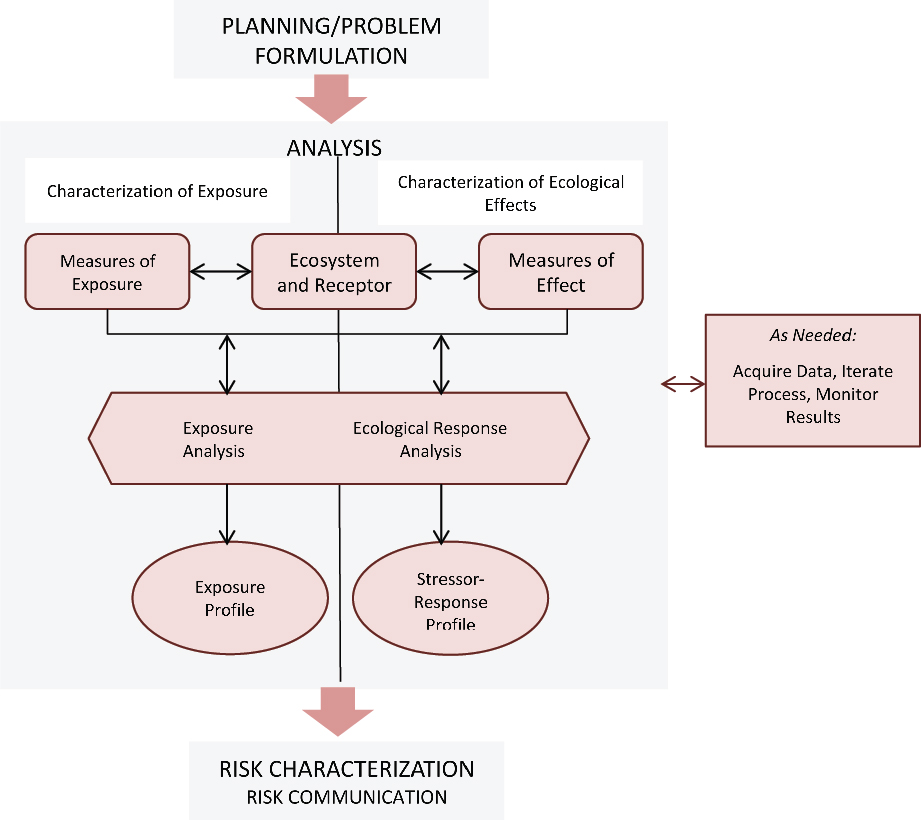Phases of ERA - Analysis
Overview

According the Guidelines for Ecological Risk Assessment (U.S. EPA 1998), during the analysis phase, risk assessors:
- Select data (e.g., monitoring data, modeling information) that can be used to characterize exposure and ecological effects.
- Characterize exposure by examining sources of the stressor(s), distribution of the stressor(s) in the environment, and extent of contact with stressor(s).
- Characterize effects by examining stressor-response relationshipsA stressor-response profile is the product of characterization of ecological effects in the analysis phase of ecological risk assessment. The stressor-response profile summarizes the data on the effects of a stressor and the relationship of the data to the assessment endpoint. , evidence for cause and effect, and relationships between measures of effect and assessment endpoints An explicit expression of the environmental value to be protected, operationally defined as an ecological entity and its attributes. .
- Summarize conclusions about exposure and effects.
The products from the analysis phase are two profiles, one for exposure and one for stressor response. These products provide the basis for risk characterization.
Appendix D to the 1998 Guidelines for Ecological Risk Assessment (U.S. EPA, 1998) provides examples of the types of products developed during the analysis phase.
Exposure Characterization
Exposure characterization describes sources of stressors, stressor distribution in the environment, and ecological receptor contact or co-occurrenceExposure that is not the result of direct contact with a stressor, but occurs when a stressor, due to its spatial or temporal proximity to a receptor, results in significantly altered receptor response. with stressors.
The goal of the exposure characterization step is to produce a summary exposure profile that:
- Identifies the receptor.
- Describes the course a stressor takes from the source to the receptor (i.e., fate and transport, exposure pathway). (See the Stressors Tool Set of EPA-Eco-Box for tools related to fate and transport of contaminants.)
- Describes the intensity and spatial and temporal extent of co-occurrence or contact.
- Describes the impact of variability and uncertainty Uncertainty represents a lack of knowledge about factors affecting exposure or risk and can lead to inaccurate or biased estimates of exposure. The types of uncertainty include: scenario, parameter, and model. on exposure estimates and reaches a conclusion about the likelihood that exposure will occur.
The exposure profile provides a complete picture of how, when, and where exposure occurs or has occurred. It is developed by evaluating sources and releases of the stressor, distribution of the stressor in the environment, and extent and pattern of contact with the stressor.
Ecological Effects Characterization
Ecological effects characterization evaluates stressor-response relationships or evidence that exposure to stressors causes an observed response. To characterize ecological effects, the assessor:
- Describes effects elicited by a stressor.
- Links effects to the assessment endpointsAn explicit expression of the environmental value to be protected, operationally defined as an ecological entity and its attributes..
- Performs an ecological response analysis by evaluating how the magnitude of the effects change with varying stressor levels and the evidence that the stressor causes the effect, and then linking the effects with the assessment endpoint.
- Summarizes conclusions in a stressor-response profile.
The goal of the ecological effects characterization step is to produce a summary stressor-response profile. The profile is used to identify receptors that are affected by stressor and characterize the nature and intensity of the effect(s).
Where appropriate, the stressor-response profile will identify the time scale for recovery and causal information that links the stressor with observed effects.
The stressor-response profile also describes how changes in measures of effects relate to changes in assessment endpoints and discusses the uncertainties and assumptions associated with the analysis.
The exposure profile is combined with a stressor-response profile to estimate risks.
Phase 2 of the ERA: Analysis
Goal
Provide the information necessary for determining or predicting ecological responses to stressors under exposure conditions of interest. Analysis connects problem formulation with risk characterization.
Who is involved?
Risk assessor(s) (in consultation with Risk Manager)
Approach
- Exposure Characterization
- Describe sources of stressors, their distribution in the environment, and their contact or co-occurrenceExposure that is not the result of direct contact with a stressor, but occurs when a stressor, due to its spatial or temporal proximity to a receptor, results in significantly altered receptor response. with ecological receptors.
- Ecological Effects Characterization
- Evaluate stressor- response relationships or evidence that exposure to stressors causes an observed response.
Products
- Exposure Characterization
- Exposure profile that describes source(s) of the stressors, receptors, fate and transport of the stressor and exposure pathways, extent of exposure, impact of variability and uncertaintiesUncertainty represents a lack of knowledge about factors affecting exposure or risk and can lead to inaccurate or biased estimates of exposure. The types of uncertainty include: scenario, parameter, and model. in exposure estimates, and conclusions about the likelihood that exposure will occur.
- Ecological Effects Characterization
- Stressor-response profileA stressor-response profile is the product of characterization of ecological effects in the analysis phase of ecological risk assessment. The stressor-response profile summarizes the data on the effects of a stressor and the relationship of the data to the assessment endpoint. that describes the effects to receptors, the cause-and-effect relationships, how fast the receptor recovers, relationships between the assessment endpoints and measures of effect, and the uncertainties and assumptions associated with the analysis.
Source: U.S. EPA 1998
The analysis phase within the overall ecological risk assessment process is illustrated below (adapted from U.S. EPA, 1998).

References
- U.S. EPA 1998.
